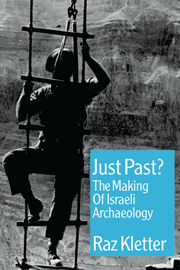Book contents
- Frontmatter
- Dedication
- Contents
- List of illustrations
- Introduction
- Acknowledgements
- Abbreviations
- 1 Archaeology and the 1948 War
- 2 Abandoned places, new places
- 3 Foreign aid
- 4 Frozen funds
- 5 A battalion of guards
- 6 Relief work
- 7 Man robs his land: “agreement” with General Dayan
- 8 “Gold of Ophir for Beth-Horon”: 3,000 shekels
- 9 The building beyond the border: the PAM, 1948–67
- 10 A building of dreams: a home for the IDAM and the origins of the Israel Museum, Jerusalem
- 11 A dead man on the council: the story of the supreme archaeological body in Israel
- 12 “But trust comes from the heart”: travels with the Government Tourist Corporation
- 13 “Whether in a courtyard of a synagogue, in a courtyard adjacent to a synagogue, or under a synagogue”: the Safad affair
- 14 The policy of salvage and early Israeli excavations
- 15 Myths and conclusions
- Appendix: other documents from the IDAM files
- Bibliography
- Author index
- Index
11 - A dead man on the council: the story of the supreme archaeological body in Israel
- Frontmatter
- Dedication
- Contents
- List of illustrations
- Introduction
- Acknowledgements
- Abbreviations
- 1 Archaeology and the 1948 War
- 2 Abandoned places, new places
- 3 Foreign aid
- 4 Frozen funds
- 5 A battalion of guards
- 6 Relief work
- 7 Man robs his land: “agreement” with General Dayan
- 8 “Gold of Ophir for Beth-Horon”: 3,000 shekels
- 9 The building beyond the border: the PAM, 1948–67
- 10 A building of dreams: a home for the IDAM and the origins of the Israel Museum, Jerusalem
- 11 A dead man on the council: the story of the supreme archaeological body in Israel
- 12 “But trust comes from the heart”: travels with the Government Tourist Corporation
- 13 “Whether in a courtyard of a synagogue, in a courtyard adjacent to a synagogue, or under a synagogue”: the Safad affair
- 14 The policy of salvage and early Israeli excavations
- 15 Myths and conclusions
- Appendix: other documents from the IDAM files
- Bibliography
- Author index
- Index
Summary
In his tribute to Chamberlain of 12 November 1940, Sir Winston Churchill (1949: 487) suggested that a person is judged not by what he or she does or does not do, but by the sincerity of his or her actions: integrity. Armed with integrity, whatever happens, one marches always “in the ranks of honour”. In this chapter I shall follow the tortuous, at times bizarre path of the history of the highest archaeological body in Israel, the “Archaeological Council”. This route takes us through a bitter and prolonged conflict between the IDAM and the IES/Hebrew University. So bear with patience the many committees and councils, mercilessly abandoned like bones of Leviathans on the forsaken shores of Israeli archaeology.
THE FIRST ARCHAEOLOGICAL COUNCIL
At first relations between the IDAM, the IES and the Hebrew University were very cordial. Until 1948 Yeivin was a member of the IES managing committee and editor of almost all volumes of the society's bulletin, the Bulletin of the Israel Exploration Society (BIES) (BIES 14 (1947/48): 73). Mazar and Yeivin served together in 1948 as archaeological army officers, and the IES blessed the establishment of the IDAM, “excellent in its choice of workers and strength” (BIES 15 (1949/50): 45, cf. 118–19; BIES 18 (1953/54): 94, 104).
- Type
- Chapter
- Information
- Just Past?The Making of Israeli Archaeology, pp. 214 - 249Publisher: Acumen PublishingPrint publication year: 2006



